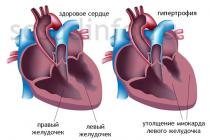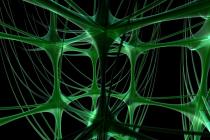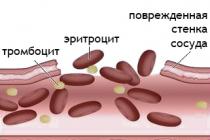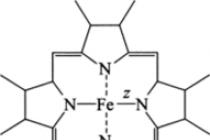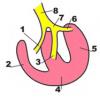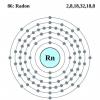The study of the trophic relationship between the autonomic nervous system and the tissue it innervates is one of the most difficult questions. Most of the evidence currently available for trophic function is purely indirect.
It is still not clear whether all neurons of the autonomic nervous system have a trophic function, or this is the prerogative of only the sympathetic part, and whether mechanisms related to triggering activity are solely responsible for them, i.e., various neurotransmitters, or other biologically active substances?
It is well known that in the process of prolonged work the muscle gets tired, as a result of which its work decreases and may finally stop completely.
It is also known that after more or less rest, the performance of tired muscles is restored. What “relieves” muscle fatigue, and does the sympathetic nervous system have something to do with it?
L.A. Orbeli (1927) found that if you irritate the motor nerves and thereby bring the muscles of the frog limb to significant fatigue, then it quickly disappears and the limb again acquires the ability to work for a relatively long time, if stimulation of the sympathetic trunk of this same limbs.
Thus, the inclusion in the work of the sympathetic nerve, which changes the functional state of the tired muscle, eliminates the resulting fatigue and makes the muscle work again. In the adaptive trophic action of the sympathetic nervous system, L.A. Orbeli distinguished two interrelated aspects. The first is adaptation. It determines the functional parameters of the working body. The second ensures the maintenance of these parameters through physical and chemical changes in the level of tissue metabolism.
The state of sympathetic innervation has a significant effect on the content in the muscle of a number of chemicals that play an important role in its activity: lactic, acids, glycogen, creatinine.
Sympathetic fiber also affects the ability of muscle tissue to conduct electricity, significantly affects the excitability of the motor nerve, etc.
Based on all these data, it was concluded that the sympathetic nervous system, without causing any structural changes in the muscle, at the same time adapts the muscle, changing its physical and chemical properties, and makes it more or less sensitive to those impulses that come to it along motor fibers. This makes her work more tailored to the needs of the moment.
It was suggested that the enhancement of the work of a tired skeletal muscle under the influence of irritation of the sympathetic nerve approaching it occurs due to contractions of blood vessels and, accordingly, the entry of new portions of blood into the capillaries, however, this assumption was not confirmed during subsequent studies.
It turned out that this phenomenon can be reproduced not only on the bloodless, but also on the muscle, the vessels of which are filled with vaseline oil.
"Physiology of the autonomic nervous system"
HELL. Nozdrachev
It has been shown experimentally that the performance of a tired skeletal muscle increases if its sympathetic nerve is simultaneously stimulated. By itself, stimulation of sympathetic fibers does not cause muscle contraction, but changes the state of muscle tissue - it increases its susceptibility to somatic nerve impulses. Such an increase in muscle performance is the result of an increase in metabolic processes under the influence of sympathetic excitations: oxygen consumption increases, the content of ATP, creatine phosphate, and glycogen increases. It is believed that one of the areas of application of this influence is the neuromuscular synapse.
Along with this, it was also discovered that stimulation of sympathetic fibers can significantly change the excitability of receptors, the functional properties of the central nervous system. Based on these and many other facts, L.A. Orbeli created a theory of the adaptive-trophic function of the sympathetic nervous system. According to this theory, sympathetic influences are not accompanied by a directly visible action, but significantly increase the adaptive capabilities of the effector.
So, the sympathetic nervous system activates the activity of the nervous system as a whole, activates the body's defenses (immune processes, barrier mechanisms, blood coagulation), thermoregulation processes. Its excitement occurs under any stressful conditions and serves as the first link in the launch of a complex chain of hormonal reactions.
Particularly clearly the participation of the sympathetic nervous system is found in the formation of human emotional reactions, regardless of the reasons that cause them. So, for example, joy is accompanied by tachycardia, vasodilation of the skin, and fear is accompanied by a slowdown of the heart rate, narrowing of skin vessels, sweating, and changes in intestinal motility. Anger causes dilated pupils.
Consequently, in the process of evolutionary development, the sympathetic nervous system has turned into an instrument for mobilizing all the resources of the organism as a whole (intellectual, energy, etc.) in those cases when the very existence of the organism is threatened.
The mobilizing role of the sympathetic nervous system relies on an extensive system of its connections, which allows, through the multiplication of impulses in
numerous pre- and paravertebral ganglia instantly cause generalized reactions of almost all organs and systems of the body. A significant addition to them is the release of adrenaline into the blood from the adrenal glands, which together with it forms the sympatho-adrenaline system.
Excitation of the sympathetic nervous system leads to a change in the homeostatic constants of the body, which is expressed in an increase in blood pressure, the release of blood from the depot, the entry of enzymes, glucose into the blood, an increase in tissue metabolism, a decrease in urination, inhibition of the function of the digestive tract, etc. Maintaining the constancy of these indicators falls entirely on the parasympathetic and metasympathetic divisions.
Thus, in the sphere of control of the sympathetic nervous system, there are mainly processes associated with energy expenditure in the body, and parasympathetic and metasympathetic - with its cumulation.
Neuron trophism. Inside the neuron is a jelly-like substance called neuroplasm. The bodies of nerve cells perform a trophic function in relation to the processes, that is, they regulate their metabolism. Trophic influence on the effector cells of the body with the help of the chemicals of the nerve cells themselves. The nutritional function of glia was suggested by Golgi, proceeding from the structural relationships of nerve and glial cells and the relationship of the latter with the capillaries of the brain. The processes of protoplasmic astrocytes (vascular pedicles) are in close contact with the basement membrane of the capillaries, covering up to 80% of their surface. The trophic function of glial cells is carried out either by one astrocyte (pedicle vascular pedicle on the capillary and other processes on the neuron), or through the astrocyte - oligodendrocyte - neuron system. It has also been shown that glial cells are involved in the formation of the blood-brain barrier, which, as is known, provides the selective transfer of substances from the blood to the nervous tissue. However, it should be noted that the essential role of glial cells in the functioning of the blood-brain barrier is not recognized by all researchers. 27. Concepts of reactivity and activity in considering the functioning of a neuron.
Reactivity paradigm: a neuron, like an individual, responds to a stimulus. From the standpoint of the traditional paradigm of reactivity, an individual's behavior is a response to a stimulus. The reaction is based on the conduction of excitation along a reflex arc: from receptors through the central structures to the executive organs. In this case, the neuron turns out to be an element included in the reflex arc, and its function is to ensure the conduction of excitation. Then it is quite logical to consider the determination of the activity of this element as follows: the response to a stimulus that has acted on some part of the surface of the nerve cell can spread further through the cell and act as a stimulus to other nerve cells. Within the framework of the reactivity paradigm, the consideration of a neuron is quite methodologically consistent: a neuron, like an organism, reacts to stimuli. The impulse that the neuron receives from other cells acts as a stimulus, and the impulse of this neuron following the synaptic influx acts as a reaction. Activity paradigm: a neuron, like an individual, achieves a "result" by receiving the necessary metabolites from its microenvironment.
28. Standard ranges of the background electroencephalogram.
EEG is a method of recording the electrical activity (biopotentials) of the brain through the intact integument of the head (intact method), which makes it possible to judge its physiological maturity, functional state, the presence of focal lesions, general cerebral disorders and their nature.
(Registration of biopotentials directly from the naked brain is called electrocorticography, ECoG, and is usually performed during neurosurgical operations).
The first scientist to demonstrate the possibility of such registration of the electrical activity of the human brain was Hans Berger (work 1929-1938).
The main concepts on which the EEG characteristic is based are:
Average vibration frequency
Maximum amplitude
The total background EEG of the cortex and subcortical formations of the brain of animals, varying depending on the level of phylogenetic development and reflecting the cytoarchitectonic and functional features of the brain structures, also consists of slow oscillations of different frequency.
One of the main characteristics of an EEG is its frequency. However, due to the limited perceptual capabilities of a person in visual analysis of EEG, used in clinical electroencephalography, a number of frequencies cannot be accurately characterized by the operator, since the human eye selects only some of the main frequency bands that are clearly present in the EEG. In accordance with the possibilities of manual analysis, a classification of EEG frequencies was introduced according to some main ranges, which were assigned the names of the letters of the Greek alphabet:
alpha - 8-13 Hz,
beta - 14-40 Hz,
theta - 4-6 Hz,
delta - 0.5-3 Hz,
gamma - above 40 Hz, etc.).
In a healthy adult with closed eyes, the main alpha rhythm. This is the so-called synchronized EEG.
When eyes are open or when signals from other senses are received, blockage occurs alpha rhythm and appear beta waves... This is called EEG desynchronization.
Theta waves and delta wavesnormally, they are not detected in awake adults; they appear only during sleep.
On the contrary, the EEG of adolescents and children is characterized by slower and more irregular delta waves even in the waking state.
Depending on the frequency range, but also on the amplitude, waveform, topography and type of reaction, EEG rhythms are distinguished, which are also denoted by Greek letters. For example, alpha rhythm, beta rhythm, gamma rhythm, delta rhythm, theta rhythm, kappa rhythm, mu rhythm, sigma rhythm and others. It is believed that each such "rhythm" corresponds to a certain state of the brain and is associated with certain cerebral mechanisms.
Trophic function (Greek trophe - food) is manifested in a regulatory effect on the metabolism and nutrition of the cell (nervous or effector). The doctrine of the trophic function of the nervous system was developed by I.P. Pavlov (1920) and other scientists.
The main data on the presence of this function were obtained in experiments with denervation of nerve or effector cells, i.e. cutting those nerve fibers whose synapses end on the cell under study. It turned out that cells, devoid of a significant part of synapses, cover them, become much more sensitive to chemical factors (for example, to the effects of mediators). In this case, the physicochemical properties of the membrane (resistance, ionic conductivity, etc.), biochemical processes in the cytoplasm change significantly, structural changes (chromatolysis) occur, and the number of membrane chemoreceptors increases.
What is the reason for these changes? A significant factor is the constant entry (including spontaneous) of the mediator into cells, regulates membrane processes in the postsynaptic structure, and increases the sensitivity of receptors to chemical stimuli. The reason for the changes may be the release from the synaptic endings of substances ("trophic" factors) that penetrate into the postsynaptic structure and affect it.
There is evidence of the movement of some substances by the axon (axonal transport). Proteins that are synthesized in the cell body, the products of nucleic acid metabolism, neurotransmitters, neurosecret and other substances move by the axon to the nerve endings together with cellular organelles, in particular mitochondria, which apparently carry a full set of enzymes. It has been experimentally proven that fast axonal transport (410 mm in 1 day) and slow (175-230 mm in 1 day) are active processes that require the expenditure of metabolic energy. It is assumed that the transport mechanism is carried out with the help of microtubules and neurophilic axons, which slide the actin transport filaments. At the same time, ATP is released, which provides energy for the transport.
Also revealed retrograde axonal transport (from the periphery to the cell body). Viruses and bacterial toxins can enter the peripheral axon and travel along it to the cell body. For example, tetanus toxin, produced by bacteria trapped in a wound on the skin, enters the body by retrograde axon transport to the central nervous system and causes muscle cramps that can cause death. The introduction of certain substances into the area of \u200b\u200bthe cut axons (for example, the enzyme leroxidase) is accompanied by their entry into the axon and spread to the soma of the neuron.
Solving the problem of the trophic influence of the nervous system is very important for understanding the mechanism of those trophic disorders (trophic ulcers, hair loss, brittle nails, etc.) that are often observed in clinical practice.
For a long time, the prevailing belief in biology was that the nervous regulation of skeletal muscle activity was provided exclusively by the somatic nervous system. Such a concept, firmly established in the minds of researchers, was shaken only in the first third of the 20th century.
It is well known that with prolonged work a muscle gets tired: its contractions gradually weaken and may finally stop completely. Then, after some rest, the muscle's working capacity is restored. The reasons and material basis for this phenomenon remained unknown.
In 1927 L.A. Found that if by prolonged stimulation of the motor nerve to bring the frog's foot to fatigue (cessation of movement), and then, continuing motor stimulation, simultaneously irritate the sympathetic nerve, then the limb quickly resumes its work. Consequently, the activation of the sympathetic influence changed the functional state of the tired muscle, eliminated fatigue and restored its working capacity.
It was found that sympathetic nerves affect the ability of muscle fibers to conduct electrical current, on the excitability of the motor nerve. Under the influence of sympathetic innervation, the content in the muscle of a number of chemical compounds that play an important role in its activity changes: lactic acid, glycogen, creatine, phosphates. On the basis of these data, it was concluded that the sympathetic nervous system causes certain physicochemical changes in skeletal muscle tissue, regulates its sensitivity to motor impulses coming through somatic fibers, and adapts (adapts) it to the performance of loads that arise in each specific situation. It was suggested that the enhancement of the work of a tired muscle under the influence of the sympathetic nerve fiber entering it occurs due to an increase in blood flow. However, experimental verification did not confirm this opinion.
Special studies have found that all vertebrates lack direct sympathetic innervation of skeletal muscle tissue. Consequently, sympathetic influences on skeletal muscles can be carried out only through the diffusion of a mediator and, apparently, other substances secreted by vasomotor sympathetic terminals. The validity of this conclusion is confirmed by a simple experiment. If, during stimulation of the sympathetic nerve, a muscle is placed in a solution or its vessels are perfused, then substances (of an unknown nature) appear in the washing solution and perfusate, which, when injected into other muscles, cause the effect of sympathetic irritation.
The indicated mechanism of sympathetic influence is also supported by the long latency period before the manifestation of the effect, its considerable duration and the preservation of the maximum after the termination of sympathetic stimulation. Naturally, in organs endowed with direct sympathetic innervation, such as the heart, blood vessels, internal organs, etc., such a long latent time is not required for the manifestation of trophic influence.
The main evidence for the mechanisms mediating neurotrophic regulation by the sympathetic nervous system has been obtained in skeletal muscle tissue in the study of functional overload, denervation, regeneration, and crossover of nerves suitable for various types of muscle fibers. According to the results of the research, it was concluded that the trophic influence is due to a complex of metabolic processes that maintain the normal structure of the muscles, provide its needs when performing specific loads and restore the necessary resources after stopping work. A number of biologically active (regulatory) substances are involved in these processes. It has been proved that for the manifestation of trophic action, the transport of substances from the body of the nerve cell to the executive organ is necessary. This is evidenced in particular by the data obtained in experiments on muscle denervation. It is known that muscle derenvation leads to muscle atrophy (neurogenic atrophy). Based on this, at one time it was concluded that the nervous system affects muscle metabolism through the transmission of motor impulses (hence the term "atrophy from inaction"). However, it turned out that the resumption of contractions of the denervated muscle by electrical stimulation cannot stop the atrophy process. Consequently, normal muscle trophism cannot be associated only with motor activity. In these works, observations concerning the significance of axoplasm are very interesting. It turned out that the longer the peripheral end of the cut nerve, the later degenerative changes in the denervated muscle develop. Apparently, in this case, the amount of axoplasm remaining in contact with the muscle, containing substrates of trophic action transferred from the body of the neuron, was of decisive importance.
It can be considered generally accepted that the role of neurotransmitters is not limited to participation in the transmission of nerve impulses; they also affect the vital processes of innervated organs, including in the mechanisms of tissue energy supply and in the processes of plastic reimbursement of structural costs (membrane elements, enzymes, etc.).
So, catecholamines are directly involved in the implementation of the adaptive-trophic function of the sympathetic nervous system due to their ability to quickly and intensively influence metabolic processes by increasing the level of energy substrates in the blood, and increasing the secretion of hormones, they also cause blood redistribution, excitation of the nervous system.
There is evidence of the participation of acetylcholine in changes in carbohydrate, protein, water, electrolyte metabolism of innervated tissues, as well as observations of the positive effect of acetylcholine injections in certain diseases of the skin, blood vessels, and the nervous system.
It is known that sensory nerve fibers also exhibit an adaptive trophic effect. Recently, it has been established that the endings of sensory fibers contain various neuroactive substances, including neuropeptides. The most commonly found neuropeptides P and a peptide associated with the calcitonin gene. It is assumed that these peptides, released from nerve endings, can have a trophic effect on the surrounding tissues.
In addition, a number of studies in recent years have shown that the dendrites of nerve cells are constantly changing in the cell culture and in the body of experimental animals. They are actively shortened (process retraction) and, as a result, their terminal parts are torn off (terminal amputation). Subsequently, instead of the lost ones, new endings grow, and the amputated terminals are destroyed. At the same time, various biologically active compounds are released, including the peptides mentioned above. it is assumed that these substances may exhibit neurotrophic effects.
QUESTIONS AND TASKS FOR SELF-CONTROL
1. What centers of the brain stem are involved in the regulation of the visceral functions of the autonomic nervous system?
2. In the regulation of what functions does the role of the hypothalamus appear?
3. From which interoreceptors do signals come to the hypothalamus? What parameters of the internal environment are changed by the receptor neurons of the medial hypothalamus?
4. Name the segmental centers of the sympathetic nervous system.
5. What formations does the peripheral part of the sympathetic nervous system consist of?
6. The axons of which nerves form the white and gray connecting branches?
7. Indicate the switching points of the white connecting branches.
8. What are pre - and postganglionic fibers? How are the postganglionic fibers emerging from the nodes of the sympathetic trunk located?
9. As part of which nerve conductors do the gray connecting branches go to their targets, and what exactly do they innervate?
10. Name the main organs innervated by postganglionic fibers of the cervical nodes of the sympathetic trunk. What nodes of the sympathetic trunk are involved in the innervation of the heart?
11. Name the prevertebral nerve plexuses and what formations they consist of.
12. Name the structural and functional signs that distinguish the parasympathetic from the sympathetic nervous system.
13. From which nuclei of the brain and spinal cord do preganglionic parasympathetic fibers come out?
14. Where do the preganglionic fibers of the ciliary node get from, and what do its efferent neurons innervate?
15. From which nucleus the preganglionic fibers of the pterygoid node emerge; indicate what formations are innervated by the neurons of this node?
16. Name the sources of innervation of the parotid, submandibular and sublingual salivary glands
17. Describe the pelvic nerve plexus. How is it formed and what does it innervate?
18. List the main structural and functional features of the metasympathetic nervous system.
19. Describe the structure of the sympathetic ganglion.
20. List the characteristic features of the structure of intramural nerve nodes.
21. Describe the structural features of the vagus nerve that distinguish it from other nerve trunks.
22. The child has been diagnosed with Hirschsprung's disease. Explain the reasons for it. How does it manifest itself?
23. The anterior root of the spinal cord was cut in the experimental animal. Will this affect the structure of the effector fibers of the somatic and autonomic nervous system?
24. A patient complains of severe sweating of the hands and armpits. What is the likely cause of this ailment?
25. Name the structural and functional features of the autonomic nerves.
26. What afferent neurons the sensitive link of the ANS reflex arc consists of.
27. What is the difference between the efferent link of the reflex arcs of the somatic and autonomic nervous systems?
28. In the hypothalamus there are special receptor neurons that are sensitive to changes in blood constants. Explain what features of the circulatory system of the hypothalamus contribute to the manifestation of this ability of these neurons.
29. What is the difference between cholinergic impulse transmission from preganglionic and postganglionic fibers of the parasympathetic system (H and M receptors).
30. What nerve branches form postganglionic fibers emerging from the nodes of the sympathetic trunk?
31. What features are characteristic for the structure of nuclei and neurons of the reticular formation of the brain stem?

